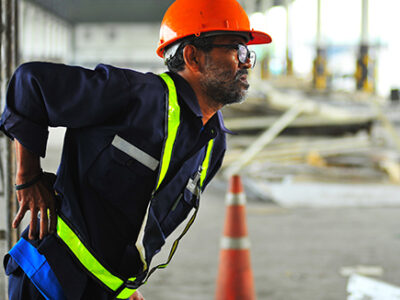In California and across the U.S., the number of people 55 and older in the labor force is increasing. It more than doubled between 1992 and 2017. Unfortunately, during that same period, the number of older workers who died on the job has gone up 56%, according to the Bureau of Labor Statistics (BLS). This is despite the fact that fatal workplace injuries overall declined 17% in that period.
In all, 38,200 workers 55 and older died from 1992 to 2017: 26% of the total workplace fatalities. In 2017, the overall workplace fatality rate came to 3.4 per 100,000 full-time equivalent workers (FTE). Among those aged 55 to 64, it was 4.6 per 100,000 FTE workers. As for those 65 and older, it was a startling 10.3 per 100,000 FTE workers. Workers 65 and older saw the highest increase in fatalities: 66% from 1992 to 2017.
Of the 38,200 killed, 3,772 were heavy-duty truck drivers and 3,217 were farmers. These, then, are the two most dangerous occupations for older workers. One in seven fatally injured older workers between 2003 and 2017 were farmers. Ninety-eight percent of the farmers fatally injured in this time period were self-employed, and 61% lived in the Midwest. Most of the fatal incidents involved a tractor or other agricultural machinery.
If a loved one suffered fatal work injuries, the family or other dependents may seek death benefits from the workers’ compensation program. If someone incurred injury but survived, then that person may file for benefits personally. Whatever the situation is like, it may be wise to have a lawyer assist with each step. Employers do, after all, often deny payment, necessitating an appeal.
Why Are Older Workers at Higher Risk?
Older workers face unique challenges in the workplace. These include:
- Physical Limitations: Aging brings reduced flexibility, slower reflexes, and diminished strength, which can increase accident risks.
- Health Conditions: Chronic illnesses such as arthritis, cardiovascular issues, and vision impairment can compromise safety.
- Cognitive Decline: Older workers may experience slower processing speeds and reduced memory, impacting hazard awareness.
- Occupational Hazards: Older workers often remain in labor-intensive industries like trucking, farming, and construction, where risks are inherently higher.
- Lack of Safety Training: Many older workers do not receive updated training on modern safety equipment, procedures, or technologies.
- Economic Pressure: Many seniors delay retirement due to rising costs, reduced pensions, and inflation, increasing their exposure to occupational risks.
High-Risk Industries for Older Workers
Truck Driving
- Risks: Long hours, fatigue, heavy machinery, highway incidents.
- Common accidents: Vehicle collisions, rollovers, load shifts.
- Did you know? Older truck drivers account for a significant portion of fatal crashes in the U.S., often due to declining reaction times and health issues.
Farming and Agriculture
- Risks: Tractor rollovers, entanglement in machinery, falls.
- 98% of fatally injured older farmers were self-employed.
- The Midwest leads in fatalities, with 61% of deaths occurring in this region.
- Safety tip: Use rollover protection systems (ROPS) and proper machinery maintenance.
Other Dangerous Industries
- Construction: Falls from heights, equipment mishandling.
- Manufacturing: Machine guarding failures, chemical exposure.
- Warehousing: Forklift accidents, repetitive strain injuries.
The Legal Framework: Workers’ Compensation and Wrongful Death Claims
Understanding the legal rights of older workers and their families is essential.
- Workers’ Compensation: A state-mandated insurance program providing benefits for work-related injuries or fatalities.
- Death Benefits: Covers funeral costs, partial wage replacement for dependents.
- Injury Claims: Cover medical expenses, rehabilitation, and lost wages.
- Wrongful Death Lawsuits: In some cases, families may file a separate civil claim for negligence or unsafe conditions, especially if third parties (like equipment manufacturers) are involved.
- Appeals Process: If claims are denied, legal assistance is crucial. Hussain Gutierrez Law can guide you through appeals, evidence gathering, and legal representation.
Learn more about filing a claim with Hussain Gutierrez Law
Global Context: How Does the U.S. Compare?
Globally, workplace fatalities among older workers are also a growing concern:
- Japan: Has one of the oldest workforces globally, with rising fatality rates in agriculture and manufacturing.
- European Union: The EU’s Directive 89/391/EEC emphasizes risk assessments for older workers, but implementation varies.
- Australia: Workplace deaths among older farmers mirror U.S. trends, with tractors being the leading cause.
A global comparison shows the need for international collaboration and adoption of best practices in safety, training, and legal protections.
The Economic and Psychological Impact of Older Worker Fatalities
- Economic Costs:
- Lost productivity, higher insurance premiums, legal settlements, and replacement training costs impact industries.
- Families may lose primary sources of income, face long-term financial hardship, and accrue medical debt.
- Psychological Toll:
- Families endure grief, trauma, and often prolonged legal battles.
- Surviving coworkers may experience post-traumatic stress disorder (PTSD) or anxiety, impacting workplace morale and safety culture.
- Support programs, grief counseling, and peer networks are critical in recovery.
Safety Innovations for Older Workers
- Technology Solutions: Wearable safety sensors, fall detection devices, fatigue monitoring systems.
- Ergonomic Adjustments: Anti-fatigue mats, adjustable equipment, and assistive tools.
- Policy Recommendations:
- Regular safety training updates.
- Risk assessments tailored for age groups.
- Age-inclusive design standards in workplaces.
FAQs: Protecting Older Workers and Navigating Compensation
What benefits are available for families of workers who die on the job?
Families may receive workers’ compensation death benefits, covering funeral costs and a percentage of lost income. In some cases, wrongful death lawsuits can also provide additional compensation.
Can older workers file for workers’ compensation if they’re over retirement age?
Absolutely. There are no age restrictions on filing workers’ compensation claims in the U.S.
How do I appeal a denied claim?
Contact a workers’ compensation attorney to gather evidence, medical records, and expert testimonies. Our team at Hussain Gutierrez Law specializes in helping families and workers appeal denied claims.
What are the most dangerous jobs for older workers?
Farming, truck driving, construction, and manufacturing top the list due to machinery hazards, heavy lifting, and environmental risks.
Are there advocacy groups for older worker safety?
Yes! Organizations like the National Council on Aging (NCOA), AARP, and NIOSH advocate for older worker protections and provide resources for safety and legal rights.
Take Action: Protect Your Rights with Hussain Gutierrez Law
If you or a loved one has been impacted by a workplace injury or fatality, don’t navigate the legal system alone. At Hussain Gutierrez Law, we’re dedicated to fighting for your rights, securing benefits, and holding negligent parties accountable.
Contact us today for a free consultation: https://hussaingutierrezlaw.com/
Learn about your options, book a call, ask a question, or request a case evaluation.
Your safety and future matter. Let us help you secure the justice you deserve.



